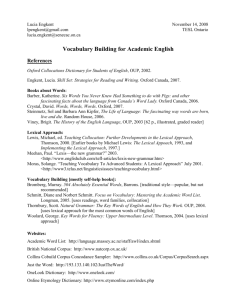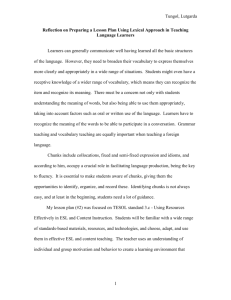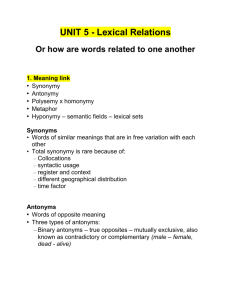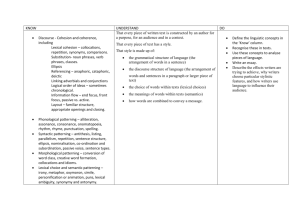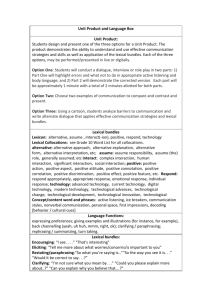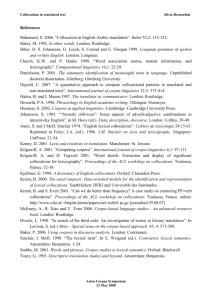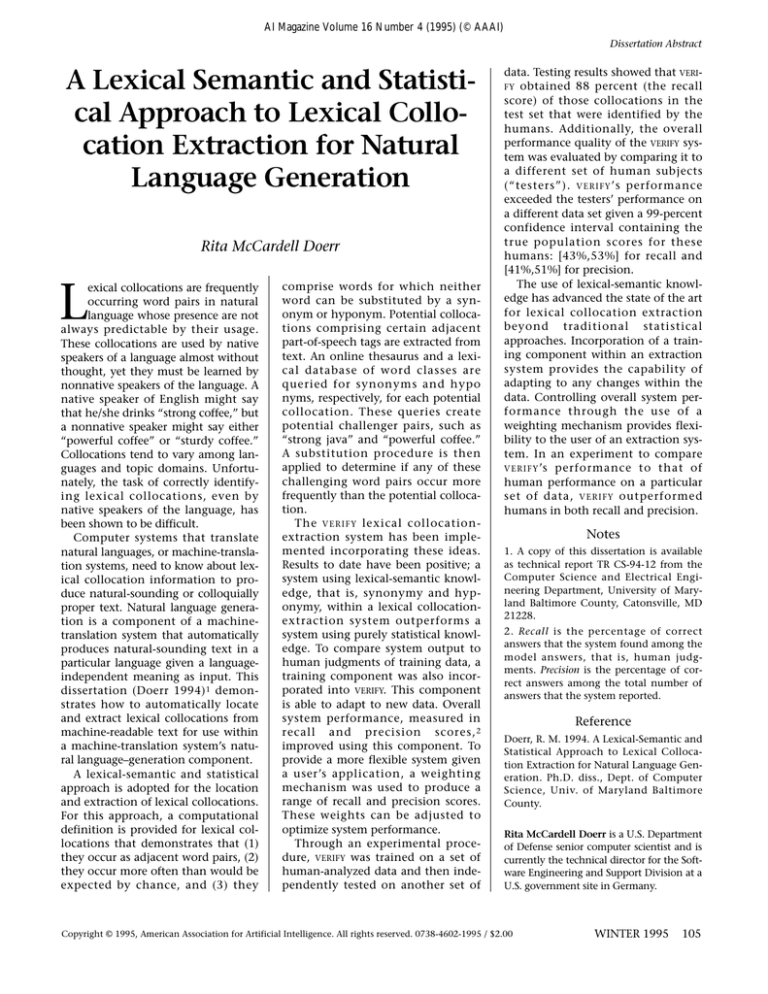
AI Magazine Volume 16 Number 4 (1995) (© AAAI)
Dissertation Abstract
A Lexical Semantic and Statistical Approach to Lexical Collocation Extraction for Natural
Language Generation
Rita McCardell Doerr
L
exical collocations are frequently
occurring word pairs in natural
language whose presence are not
always predictable by their usage.
These collocations are used by native
speakers of a language almost without
thought, yet they must be learned by
nonnative speakers of the language. A
native speaker of English might say
that he/she drinks “strong coffee,” but
a nonnative speaker might say either
“powerful coffee” or “sturdy coffee.”
Collocations tend to vary among languages and topic domains. Unfortunately, the task of correctly identifying lexical collocations, even by
native speakers of the language, has
been shown to be difficult.
Computer systems that translate
natural languages, or machine-translation systems, need to know about lexical collocation information to produce natural-sounding or colloquially
proper text. Natural language generation is a component of a machinetranslation system that automatically
produces natural-sounding text in a
particular language given a languageindependent meaning as input. This
dissertation (Doerr 1994) 1 demonstrates how to automatically locate
and extract lexical collocations from
machine-readable text for use within
a machine-translation system’s natural language–generation component.
A lexical-semantic and statistical
approach is adopted for the location
and extraction of lexical collocations.
For this approach, a computational
definition is provided for lexical collocations that demonstrates that (1)
they occur as adjacent word pairs, (2)
they occur more often than would be
expected by chance, and (3) they
comprise words for which neither
word can be substituted by a synonym or hyponym. Potential collocations comprising certain adjacent
part-of-speech tags are extracted from
text. An online thesaurus and a lexical database of word classes are
queried for synonyms and hypo
nyms, respectively, for each potential
collocation. These queries create
potential challenger pairs, such as
“strong java” and “powerful coffee.”
A substitution procedure is then
applied to determine if any of these
challenging word pairs occur more
frequently than the potential collocation.
The V E R I F Y lexical collocationextraction system has been implemented incorporating these ideas.
Results to date have been positive; a
system using lexical-semantic knowledge, that is, synonymy and hyponymy, within a lexical collocationextraction system outperforms a
system using purely statistical knowledge. To compare system output to
human judgments of training data, a
training component was also incorporated into VERIFY. This component
is able to adapt to new data. Overall
system performance, measured in
recall and precision scores, 2
improved using this component. To
provide a more flexible system given
a user’s application, a weighting
mechanism was used to produce a
range of recall and precision scores.
These weights can be adjusted to
optimize system performance.
Through an experimental procedure, VERIFY was trained on a set of
human-analyzed data and then independently tested on another set of
data. Testing results showed that VERIobtained 88 percent (the recall
score) of those collocations in the
test set that were identified by the
humans. Additionally, the overall
performance quality of the VERIFY system was evaluated by comparing it to
a different set of human subjects
(“testers”). V E R I F Y ’s performance
exceeded the testers’ performance on
a different data set given a 99-percent
confidence interval containing the
true population scores for these
humans: [43%,53%] for recall and
[41%,51%] for precision.
The use of lexical-semantic knowledge has advanced the state of the art
for lexical collocation extraction
beyond traditional statistical
approaches. Incorporation of a training component within an extraction
system provides the capability of
adapting to any changes within the
data. Controlling overall system performance through the use of a
weighting mechanism provides flexibility to the user of an extraction system. In an experiment to compare
V E R I F Y ’s performance to that of
human performance on a particular
set of data, V E R I F Y outperformed
humans in both recall and precision.
FY
Notes
1. A copy of this dissertation is available
as technical report TR CS-94-12 from the
Computer Science and Electrical Engineering Department, University of Maryland Baltimore County, Catonsville, MD
21228.
2. Recall is the percentage of correct
answers that the system found among the
model answers, that is, human judgments. Precision is the percentage of correct answers among the total number of
answers that the system reported.
Reference
Doerr, R. M. 1994. A Lexical-Semantic and
Statistical Approach to Lexical Collocation Extraction for Natural Language Generation. Ph.D. diss., Dept. of Computer
Science, Univ. of Maryland Baltimore
County.
Rita McCardell Doerr is a U.S. Department
of Defense senior computer scientist and is
currently the technical director for the Software Engineering and Support Division at a
U.S. government site in Germany.
Copyright © 1995, American Association for Artificial Intelligence. All rights reserved. 0738-4602-1995 / $2.00
WINTER 1995
105


